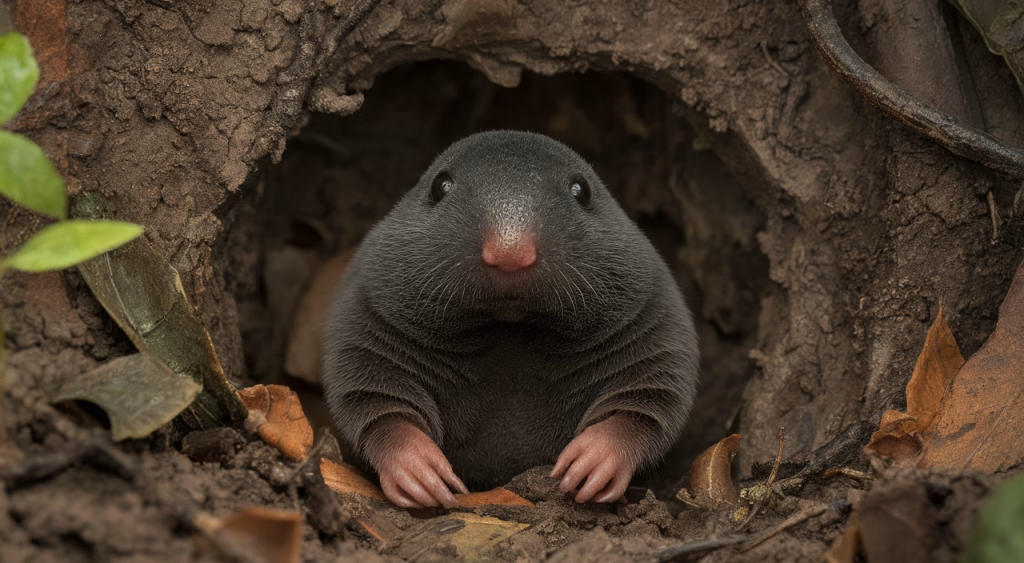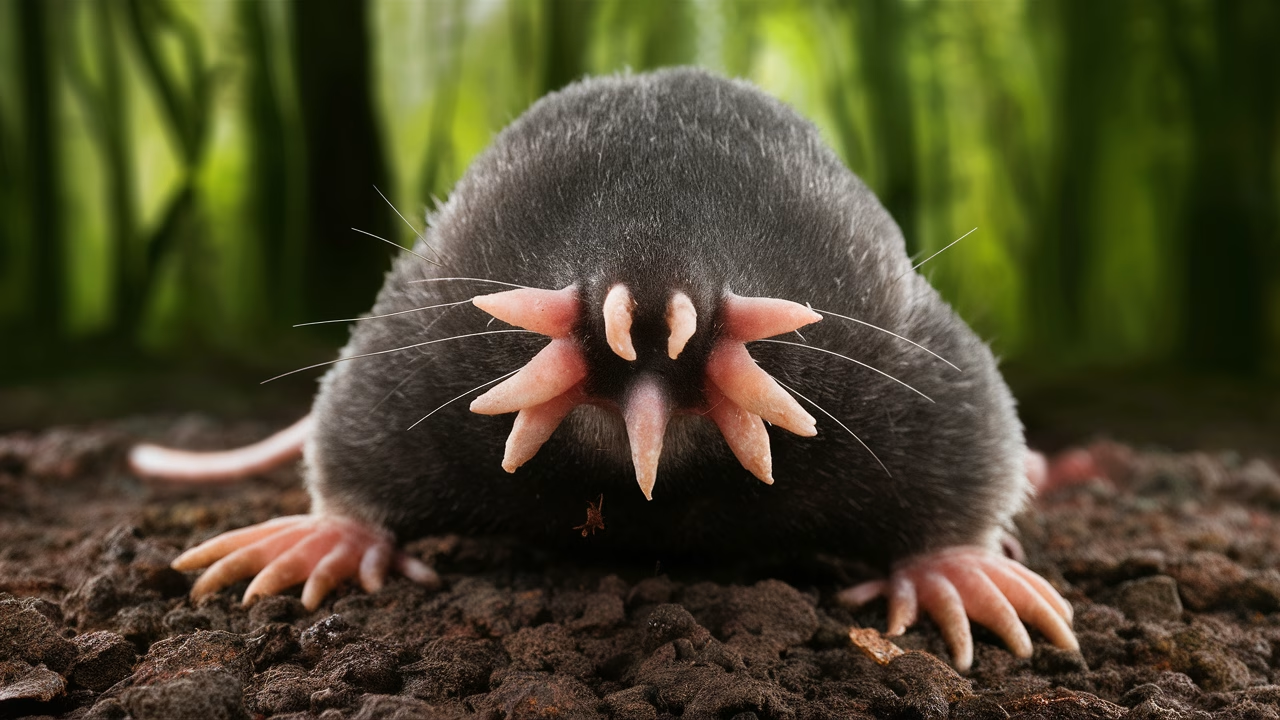With virtually no eyesight and a life spent mostly in soil or murky waters, the star-nosed mole has evolved something truly remarkable — a star-shaped nose that acts like nature’s fastest and most sensitive touch organ. This extraordinary sensory perception allows the mole to detect and identify prey in a fraction of a second, making it a marvel of evolutionary specialization with unique adaptations that few creatures can match.
TL;DR: Nature’s Ultimate Sensory Experts — Star-Nosed Mole at a Glance
- Amazing Sense Organ: The star-shaped nose comprises 22 fleshy appendages packed with over 25,000 Eimer’s organs — microscopic sensory receptors.
- Lightning-Fast Processing: This mole identifies and consumes prey in under 200 milliseconds — faster than the human eye can track movement.
- Dual-Habitat Adaptation: Equally at home on land and underwater, their unique adaptations help them survive year-round.
- Behavioral Curiosity: These creatures exhibit highly specialized foraging behavioral patterns rarely seen in other mammals.
- Key to Understanding Sensory Systems: Studying them provides insight into how tactile information can be processed at lightning speeds.
The Incredible Adaptations of the Star-Nosed Mole
1.1 Understanding the Star-Shaped Nose
The nose of the star-nosed mole isn’t merely unusual — it’s a masterpiece of biological engineering. Shaped like a starburst with 22 finger-like rays, this organ is covered in tens of thousands of Eimer’s organs, which are touch receptors so sensitive they can detect tiny changes in pressure and texture. These unique adaptations make the star-nosed mole one of nature’s most specialized hunters.
Imagine trying to identify everything in your fridge by touch alone — blindfolded — and doing it in under a second. That’s what this mole does, constantly. It uses its extraordinary sensory perception not just to detect presence but to gain precise information about size, shape, and edibility of whatever it touches.
1.2 The Science Behind the Sensory-Motor Organ
What may seem like a bizarre appendage is actually a powerful brain extension. These sensory rays act as extensions of the mole’s nervous system, delivering data to highly specialized brain regions. Interestingly, the star-nosed mole’s brain devotes a larger portion of its somatosensory cortex to interpreting nose signals than most mammals do for processing vision.
Essentially, this nose functions as a high-speed biological scanner, sweeping across the environment during environmental exploration, coding sensory input into neural signals that the mole processes at breakneck speed.
How the Star-Nosed Mole Utilizes its Unique Nose
2.1 The Role of the Appendages in Sensory Perception
Each of the 22 rays on the mole’s ‘star’ can move independently, allowing it to rapidly scan its surroundings with remarkable sensory perception. Among these rays, one in particular — the eleventh — acts as a “fovea,” similar to the central focal point in the human eye. It serves as the finer-focus touch ray, pausing over interesting objects for further inspection.
This precise form of sensory perception allows the star-nosed mole to perform rapid targeting — identifying and reacting to stimuli in as little as 8 milliseconds, showcasing one of nature’s most impressive unique adaptations.
2.2 Behavioral Patterns of the Mole
Star-nosed moles are hyperactive foragers with distinctive behavioral patterns. They display compulsive tunneling behavior and are constantly sweeping their nose in short bursts. Behavioral studies show they follow distinct search patterns, optimizing the use of their rays for maximum environmental feedback during their environmental exploration.
When they find prey — often small invertebrates or aquatic insects — the delay between detection and ingestion is embarrassingly short for anything trying to escape. These behavioral patterns, paired with efficient energy usage, make them unique predators in terms of hunting performance.
Environmental Exploration of the Star-Nosed Mole
3.1 Adaptations for Survival
The star-nosed mole’s lifestyle demands extreme versatility through unique adaptations. Its front limbs are shaped like paddles, built for digging through moist substrates with impressive power. Meanwhile, its water-loving instincts come from a waterproof coat and airtight nostrils that close underwater. Star-nosed moles have even been filmed using their star to smell underwater by exhaling bubbles and then resucking them for scent detection — a rare trait among mammals.
In colder climates, they remain active under the snow thanks to their continuous metabolic rate and insulating tunnel systems. These subterranean thermoregulated habitats protect them from harsh surface conditions and predators while supporting their year-round environmental exploration.
3.2 Unique Features of the Mole’s Habitat
Typically, star-nosed moles prefer wetlands, forest floors, and damp meadows for their environmental exploration. Their burrows often intersect with roots, stones, and streambeds — elements requiring them to be flexible navigators. These habitats offer an abundance of soft-bodied insects, snails, and small fish, which are ideal for quick consumption.
Unlike other mole species, they also include aquatic routes in their tunnels, using underwater paths to access new feeding grounds. This combination of burrowing and ‘swimming’ locations makes them uniquely positioned for both terrestrial and aquatic ecosystems, demonstrating remarkable unique adaptations.
Comparing the Sensory Abilities of the Star-Nosed Mole
| Feature | Star-Nosed Mole | Common Mole | Human |
|---|---|---|---|
| Touch Receptors in Nose | 25,000+ | Few hundred | N/A |
| Response Speed | 8 ms sensory reaction | Slow, tactile | Visual: 200–250 ms |
| Underwater Foraging | Yes | No | Yes (but poor tactile ability) |
Final Thoughts: Why We Should Appreciate the Star-Nosed Mole
It’s easy to find the star-nosed mole odd—or even unsettling at first glance. But underneath that alien-looking exterior lies one of nature’s finest examples of how evolution shapes creatures for peak performance in specific environments. This mole is not just an oddity; it’s an elite survivalist with unique adaptations perfectly evolved for the dark, demanding spaces it calls home.
By studying the behavioral patterns, unique adaptations, and environmental exploration techniques of the star-nosed mole, we gain critical insights into how sensory systems evolve and how creatures adapt in ways that are almost magical in their precision and function. If you’re a nature lover or zoology enthusiast, appreciating these marvels of sensory perception might just deepen your admiration for the hidden complexity all around us.
Frequently Asked Questions
- What makes the star-nosed mole’s nose so effective?
Its nose is covered with tens of thousands of sensory receptors called Eimer’s organs, allowing it to process touch stimuli faster than any other mammal. - Can the star-nosed mole see?
No, its eyesight is extremely limited and likely limited to light detection only. It relies entirely on touch and smell. - Is the star-nosed mole endangered?
No, it is not currently endangered. It is found primarily in the northeastern United States and parts of Canada in damp environments. - Can a star-nosed mole smell underwater?
Yes! Uniquely, they exhale air bubbles and suck them back in to analyze scents underwater. - How fast can it detect and eat prey?
As little as 120 to 230 milliseconds between detection and ingestion has been recorded. - Where do star-nosed moles live?
In wetlands, dense soils near water bodies, forested areas, and moist meadows — often combining land and water tunnels. - What do star-nosed moles eat?
They primarily eat invertebrates, worms, aquatic insects, and even small fish.





